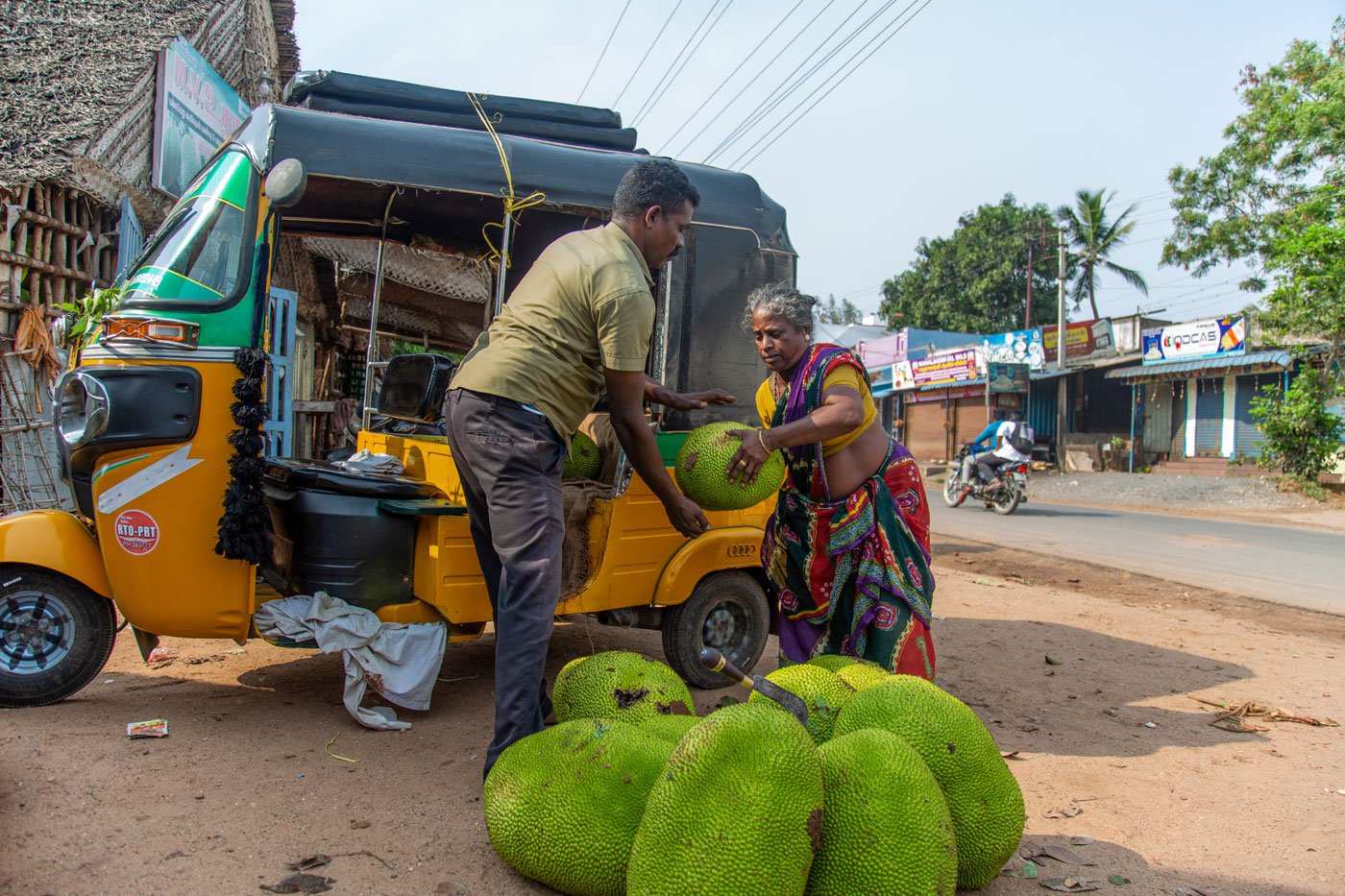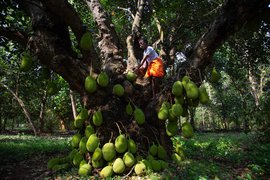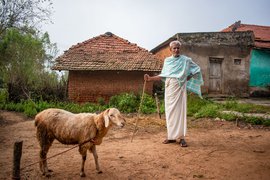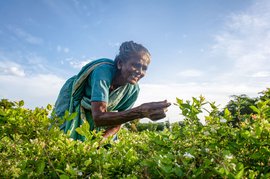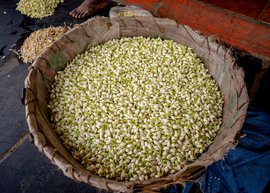It is the Best Hero Entry Scene. Five minutes after six men swear that the jackfruit trade is no job for a woman – given all the transportation, heavy lifting and risks – Lakshmi walks into the shop. She’s wearing a yellow saree, her grey hair in a bun, and gold ornaments on her ears and nose. “She’s the most important person in the business,” a farmer announces, deferentially.
“She’s the one who fixes the price for our produce.”
A. Lakshmi, 65, is the only woman jackfruit trader in Panruti – and among the very few senior women vyaparis (traders) in any agribusiness.
Panruti town in Cuddalore district, Tamil Nadu, is famous for its jackfruit. Hundreds of tonnes are bought and sold daily during the season here. Every year, Lakshmi sets the price for thousands of kilos of fruit that will be sold in the 22 shops serving as the town’s jackfruit mandis . She earns a small commission – 50 rupees for every 1,000 – from the buyer. Farmers might pay her a little something if they wish. Her daily income, she estimates, is between 1,000 and 2,000 rupees during the season.
To earn this, she works 12 hours. She begins at 1 a.m. “If there is a lot of sarakku [goods], the traders come home earlier to fetch me,” Lakshmi explains. The latest she gets to the mandi , by autorickshaw, is 3 a.m. Her work ‘day’ goes on till 1 p.m., after which she goes home and eats and rests. Until it’s time for her to go back to the market…
“I don’t know much about growing jackfruit,” she tells me, her voice hoarse from hours and hours of talking and shouting. “But I know something about selling.” Lakshmi’s being modest. After all, she’s been a trader for three decades, and before that, for 20 years, she sold the fruit on moving trains.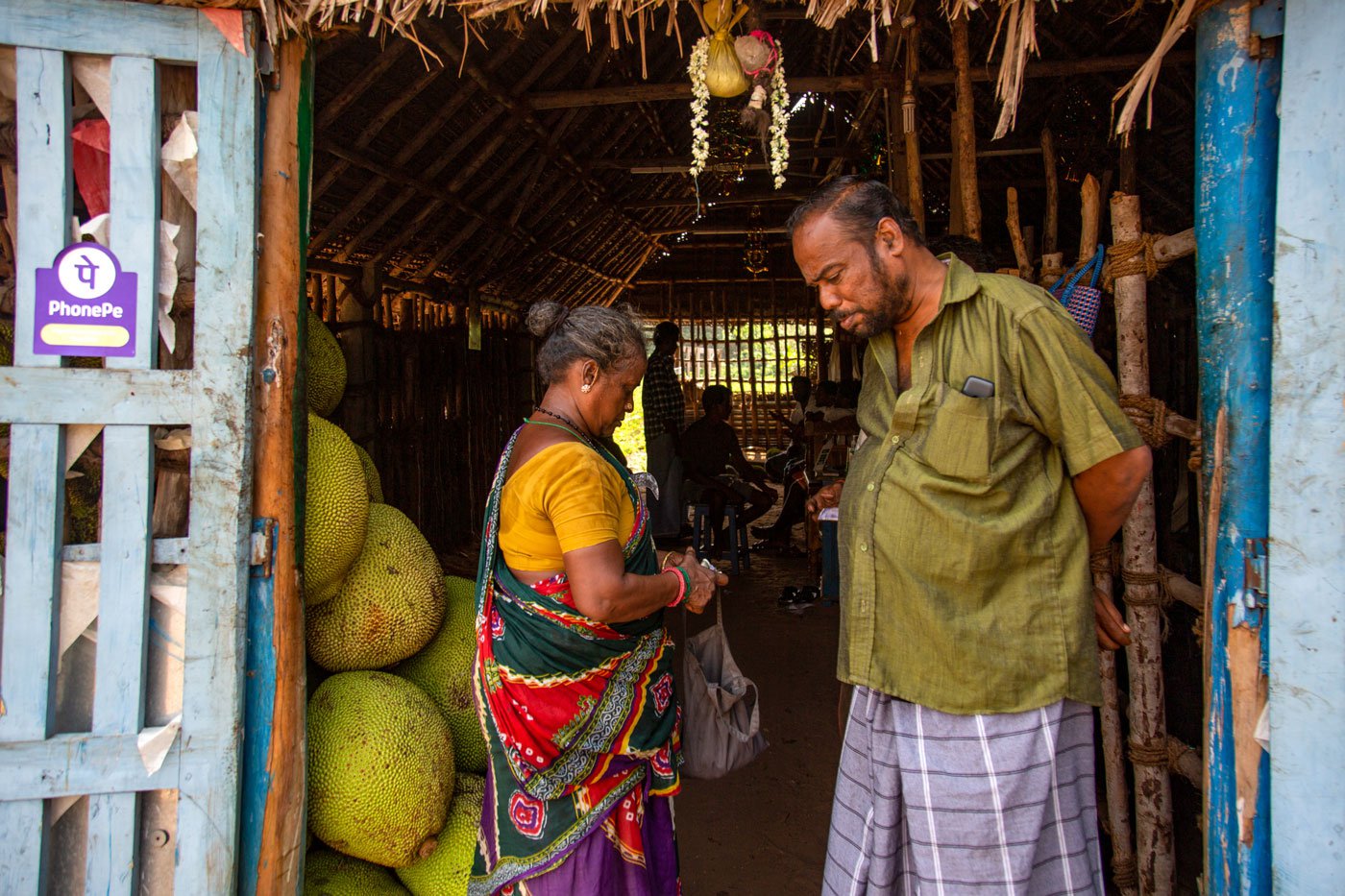
Lakshmi engaged in business at a jackfruit mandi in Panruti. She is the only woman trading the fruit in this town in Tamil Nadu's Cuddalore district
Her jackfruit journey began when she was 12. Young Lakshmi wore a half-saree and took a few pala pazhams , as the fruit is called in Tamil, and sold it on the kari vandi (passenger trains) pulled by steam engines. Now the 65-year-old lives in a house with her name on the façade – Lakshmi Vilas.
It is the house that Lakshmi built, selling, trading, one of the world’s largest fruits – jack.*****
The jackfruit season starts sometime in January or February and typically lasts a full six months. Heavy and unseasonal rains during the 2021 northeast monsoon, pushed out the flowering and fruiting by eight weeks. It was April by the time the fruits arrived in Panruti’s mandis . And the season was over by August.
‘Jack’, as the fruit is colloquially called, is native to south India’s Western Ghats. The name originates from the Malayalam term chakka . The scientific name is a mouthful: Artocarpus heterophyllus .
PARI first visited Panruti to meet traders and farmers in April 2022. Farmer and commission agent R. Vijaykumar, 40, welcomed us to his shop. With a hard earth flooring and thatched roof and sides, it is a simple structure. One for which he pays 50,000 rupees a year as rent. A bench and a few chairs are the only luxuries here.
There are streamers from a long-ago celebration, a garlanded portrait of his father, a desk, and heaps of jackfruit. The first lot near the entrance has 100 fruits, and resembles a small, green hillock.
“That’s worth 25,000 rupees,” Vijaykumar explains. The last pile – sold to two parties, and going all the way to Adyar in Chennai – has 60 fruits, and costs nearly 18,000 rupees.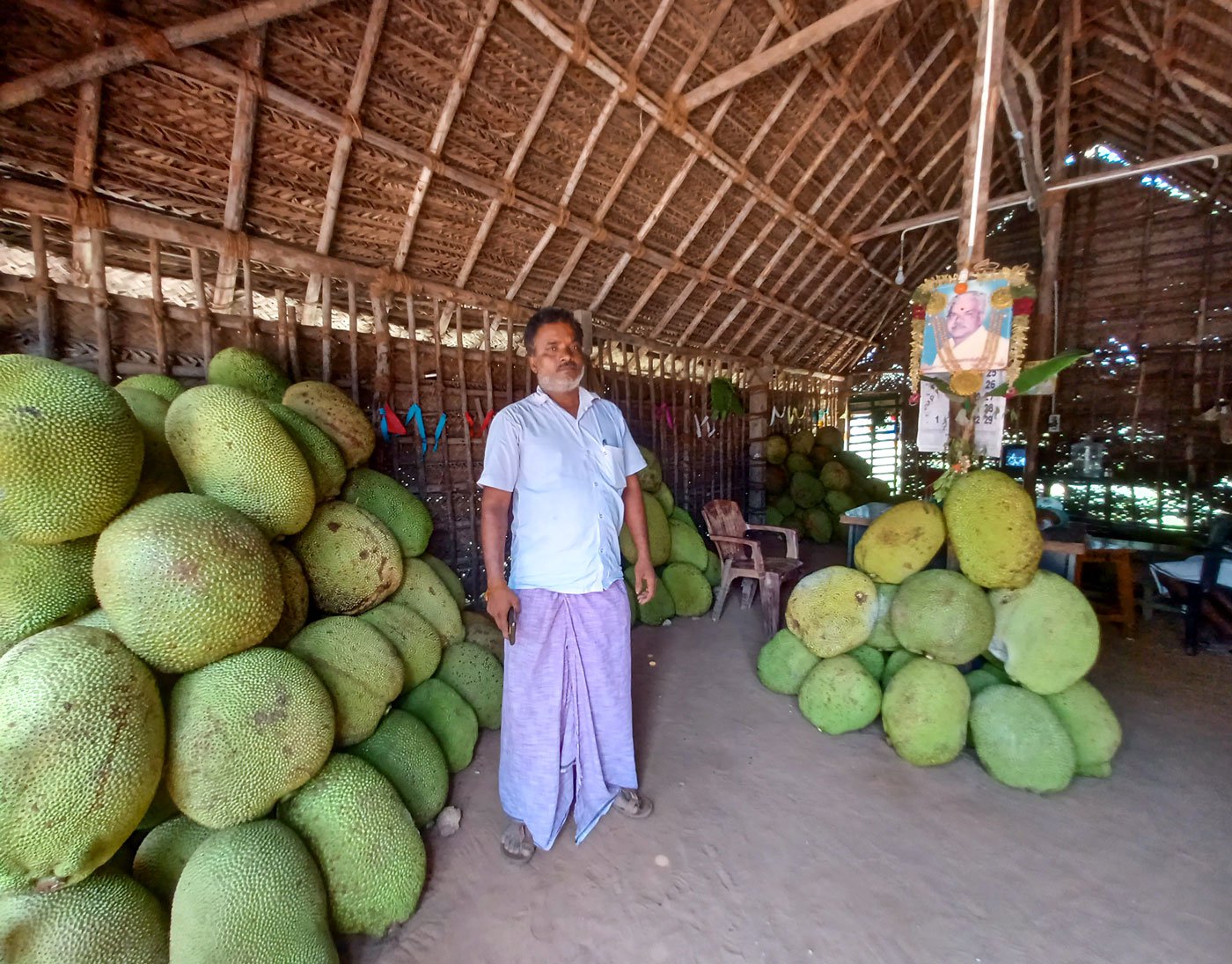
R. Vijaykumar, a farmer and commission agent, in his shop in Panruti, where heaps of jackfruit await buyers
Jackfruit is sent to Chennai, 185 kilometres away, in newspaper vans. “If it goes further north, we send it in Tata Ace trucks. Our workdays are very long. We’re here during the season from 3 or 4 a.m. till 10 p.m.,” Vijaykumar says. “There is a lot of demand for the fruit. Everybody eats it. Even diabetics eat four sollais [pods]. Only we,” he smiles, “get tired of eating it.”
There are 22 wholesale outlets in Panruti, Vijaykumar explains. His father had a shop in the same location for nearly 25 years. After his death, Vijaykumar has run it for the last 15 years. Each shop trades about 10 tonnes per day. “In all of Tamil Nadu, it is Panruti block that has the most jackfruits,” he says. And the farmers waiting on the bench for clients nod their heads and join the conversation.
The men wear veshtis or lungis , and shirts. They know each other, and nearly everybody in the business. The conversation is loud, the ringtones are louder, and the lorries that pass by are the loudest, their horns shrill and piercing at once.
K. Pattusami, 47, shares his experience of farming jackfruit. He is from Kattandikuppam village in Panruti taluk , and owns 50 trees. He also leases another 600. The going rate is 1.25 lakh rupees for every 100 trees. “I have been in the trade for 25 years,” he says, “and I can tell you, there are a lot of uncertainties.”
Even if there is a lot of fruit, Pattusami argues, “10 will rot, 10 will crack open, 10 will fall down and another 10 will be eaten by other animals.”
Overripe fruits are discarded and become animal feed. On average 5 to 10 per cent of the fruit goes waste. That’s roughly between half and one tonne per shop, per day, during the high season. A whopping quantity that farmers say is fit only for cattle.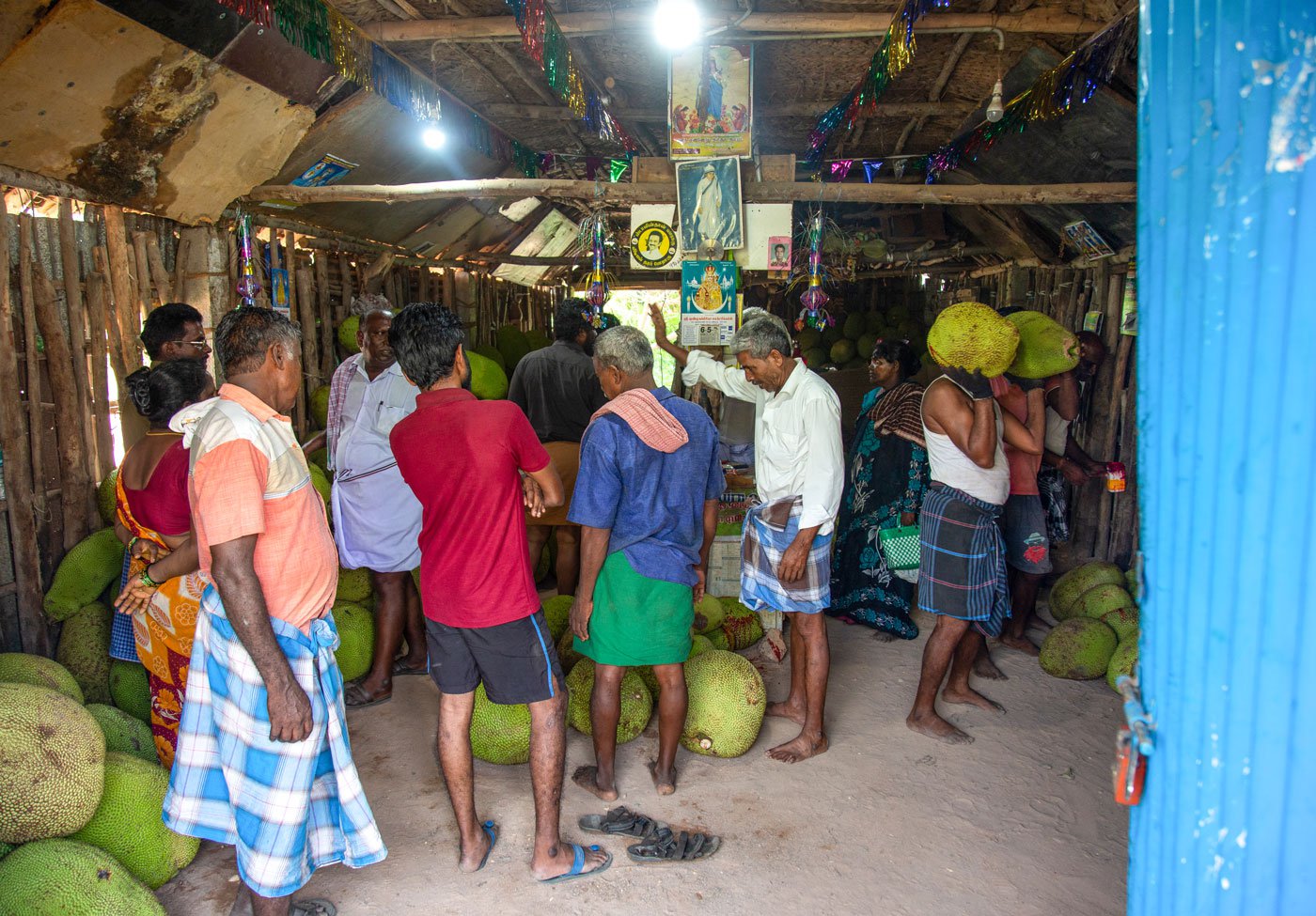
Buying, selling, fetching and carrying of jackfruits at a mandi in Panruti
And just like cattle, trees too are an investment. The rural populace considers them like stocks – the value usually appreciates, and they can be sold for a neat profit. Vijaykumar and his friends explain that once the trunk of a jackfruit tree is 8 hands wide, and 7 or 9 feet tall, “just the timber alone fetches 50,000 rupees.”
As far as possible, farmer do not cut trees, says Pattusami. “We try to increase the number [of trees]. But when there’s a need for capital – for medical emergencies or a marriage in the family – we choose a few big trees and sell them for timber.” That fetches the farmer a couple of lakhs. Enough to tide over the crisis, or take care of the kalyanam (wedding)…
“Come here,” Pattusami calls me, walking to the back of the shop. There were once dozens of big jackfruit trees there, he explains. All we can see, however, are pala kannu (baby jackfruit trees). The big trees had been sold by the owner of that land to meet expenses. Later, he planted another batch. “These are just two years old,” says Pattusami, pointing to the short, slender trees. “It’s only when the jack tree is a few years old that it fruits.”
Every year, the first crop of the season is eaten by animals. “Monkeys tear it with their mouth, and then use their hands to eat it. And squirrels love them too.”
Leasing trees, Pattusami says, serves everybody well. “See, the tree owners get a lumpsum every year, and don’t have to cut a fruit here, and another there, and get it to the market on time. Whereas someone like me – since I look after a large number of trees – I can cut 100 or 200 at once and bring to the mandi .” It’s a win-win, as long as the trees behave, the climate behaves, and the fruits grow nicely…
Sadly, even if all of that happens, the farmer still can’t set the rate. If they could, there would not be a sharp, three-fold variance in the price. Like in 2022, when a tonne of jackfruit see-sawed between 10,000 and 30,000 rupees.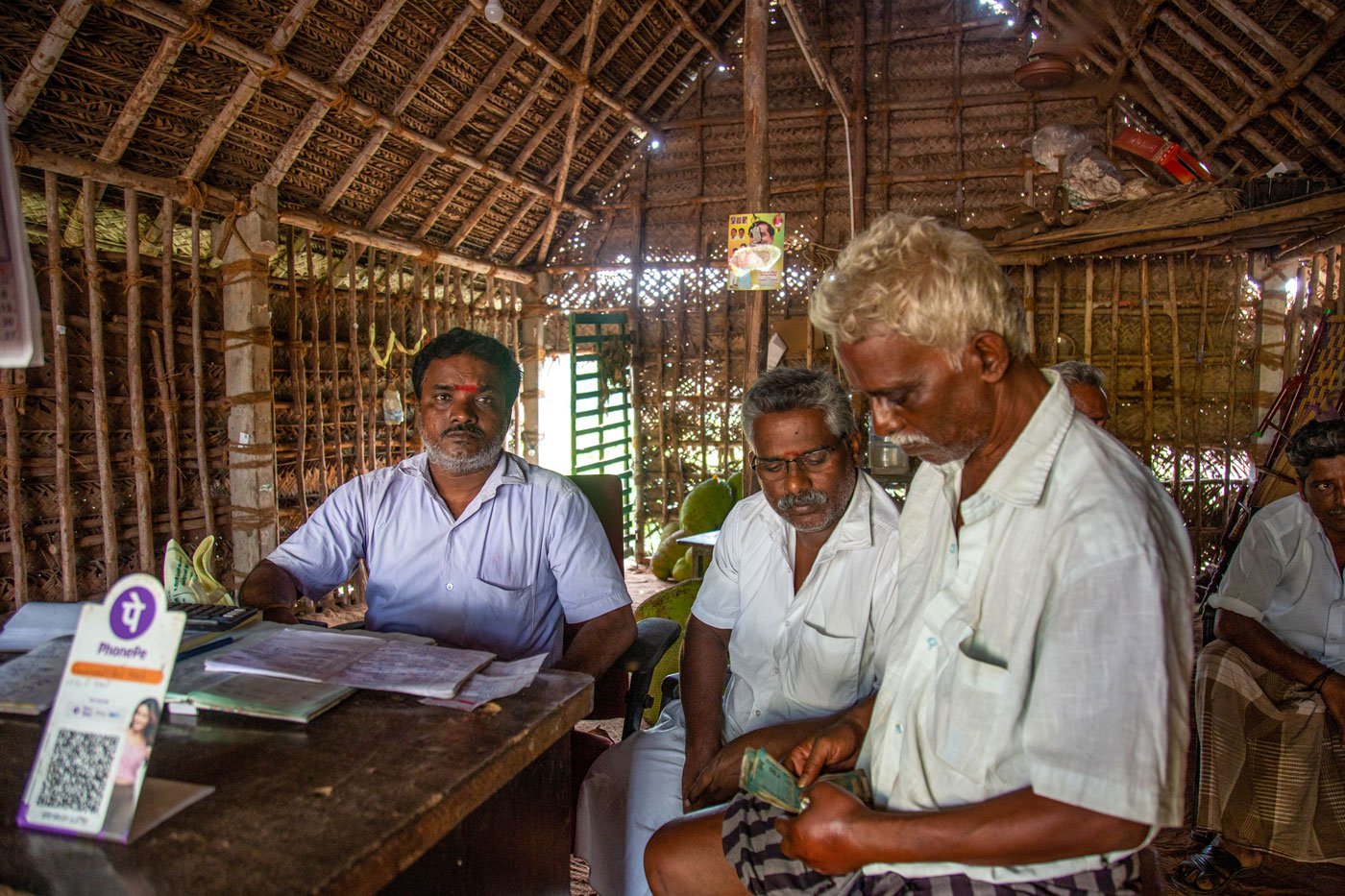
Vijaykumar (extreme left
) at his shop with farmers who have come to sell
their jackfruits
“When the rate is high, it looks as if there’s a lot of money,” Vijaykumar points to the drawer of his wooden desk. He earns a five per cent commission from both parties. “But if one client cheats you, all of it is gone. Then we’ll have to empty everything,” he shrugs, tapping the drawer, “and pay the farmer. We have a moral responsibility, isn’t it?”
The jackfruit farmers and producers formed a sangam , a committee, in early April 2022. Vijaykumar is the secretary. “It’s just 10 days old,” he says. “We haven’t yet registered it.” They have high hopes for their committee. “We want to fix the price. Then, we want to go meet the Collector and ask them to help the farmers and this industry. We would like some incentives for the producers, some facilities – mainly cold storage to preserve the fruit. Only if we are organised can we go and ask, isn’t it?”
Right now, the longest they can keep the fruits is five days. “We need some way to extend it,” Lakshmi says, hopefully. She thinks six months would be fantastic. Vijaykumar wants at least half of that. Right now, they’re forced to dump the unsold fruit in a few days, or give it away to retail sellers – who in turn chop it up and vend it on the roadside.*****
“Cold storage for jackfruit is just wishful thinking right now. You can keep a potato or apple for a long time. But there are no experiments on jackfruit. Even jackfruit chips are available only for two months after the season,” says Shree Padre, journalist and editor of the unique Kannada farm magazine Adike Patrike (Areca Magazine).
“It will be a game changer,” he says, “if at least a dozen jackfruit products are made available throughout the year.”
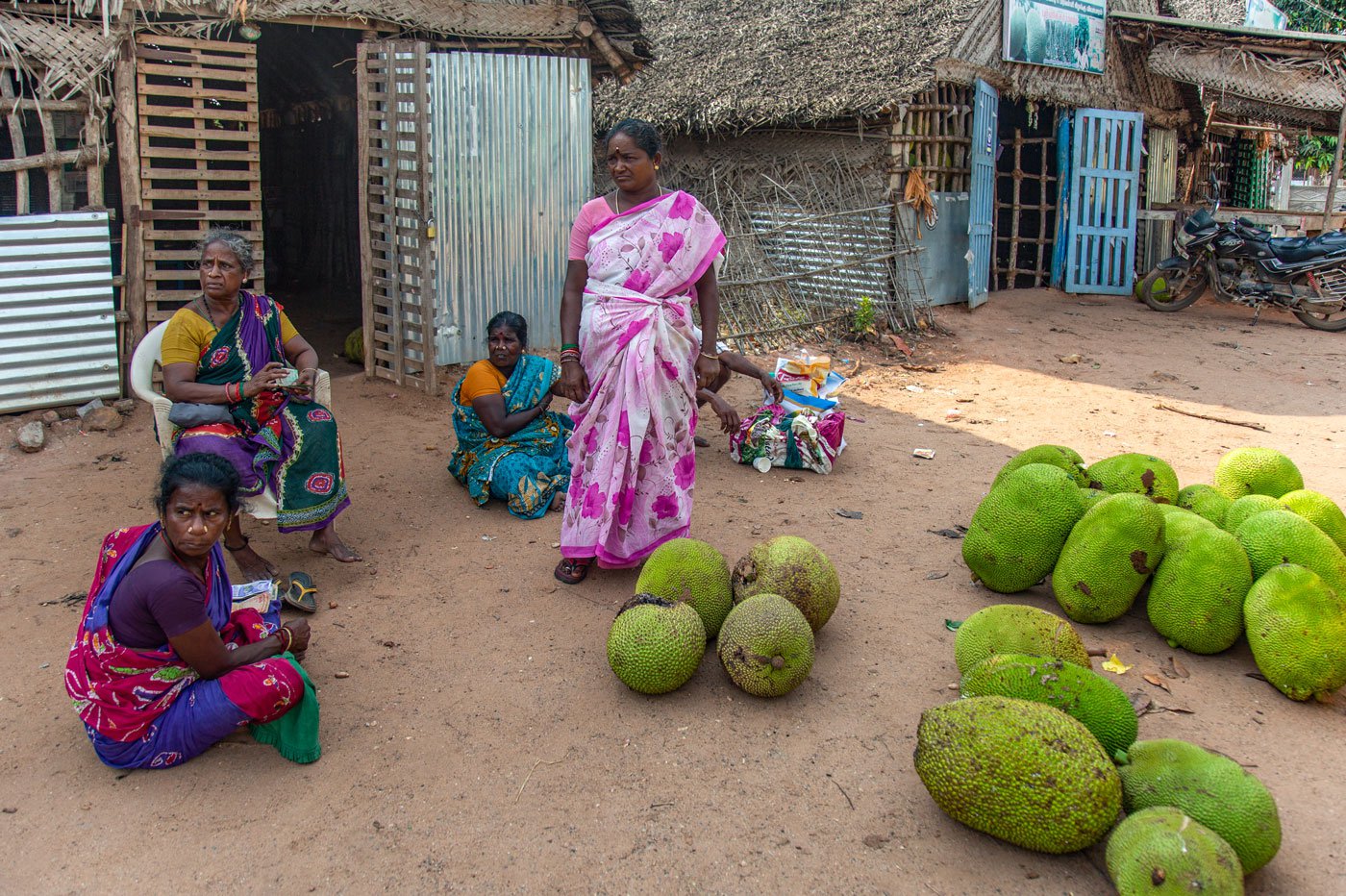
Lakshmi (on the chair) with a few women jackfruit sellers at a mandi ; she has been a jackfruit trader since 30 years
In a telephone interview with PARI, Padre discusses several important and incisive points on jackfruit cultivation. Firstly, he says, we don’t have the data on jackfruit. “The numbers are difficult to crunch, and it is confusing. Till about 10 years ago, it was a neglected, scattered crop. Panruti is a brilliant exception.”
India, Padre points out, is number one in the world in jackfruit production. “The jackfruit tree is everywhere, but we simply don’t figure in the value addition map of the globe.” Within the country, Kerala, Karnataka and Maharashtra do some value addition, while it is a nascent industry in Tamil Nadu.
And this is a shame, Padre says, since the fruit is versatile. “Jack is woefully under researched. A big tree can produce anywhere between a tonne and three of fruit.” Plus, there are five potential raw materials in each tree: first there’s tender jackfruit. Next comes the slightly grown version used as a vegetable. Then there’s the unripe fruit, used in
pappads
and chips. The fourth is the popular ripe jackfruit. And lastly, there’s the seed.
“No wonder it is called ‘superfood’,” he says. “And yet, there is no research station, no training centre. Nor are there jackfruit scientists and consultants, like, say, for banana or potato.”
As a jackfruit activist, Padre has been trying to fill many of those gaps. “I’ve been writing, disseminating information and inspiring people about jackfruit for the last 15 years. That’s nearly half the time our magazine
Adike Patrike
has existed [34 years]. We’ve done more than 34 cover stories just on jackfruit!”
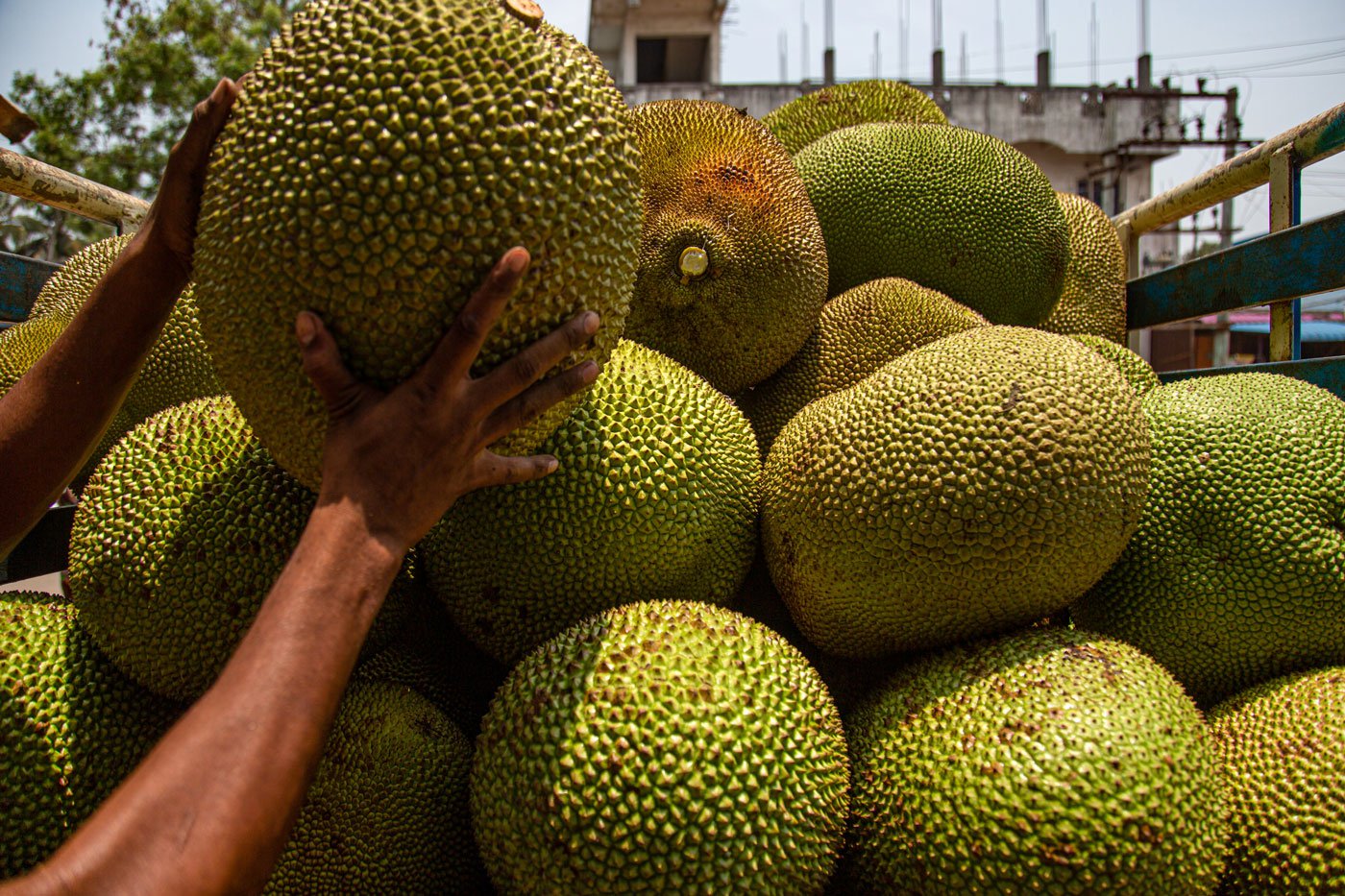
With their distinctive shape, smell and structure, jackfruits are a sight to behold but not very easy to fetch, carry and transport
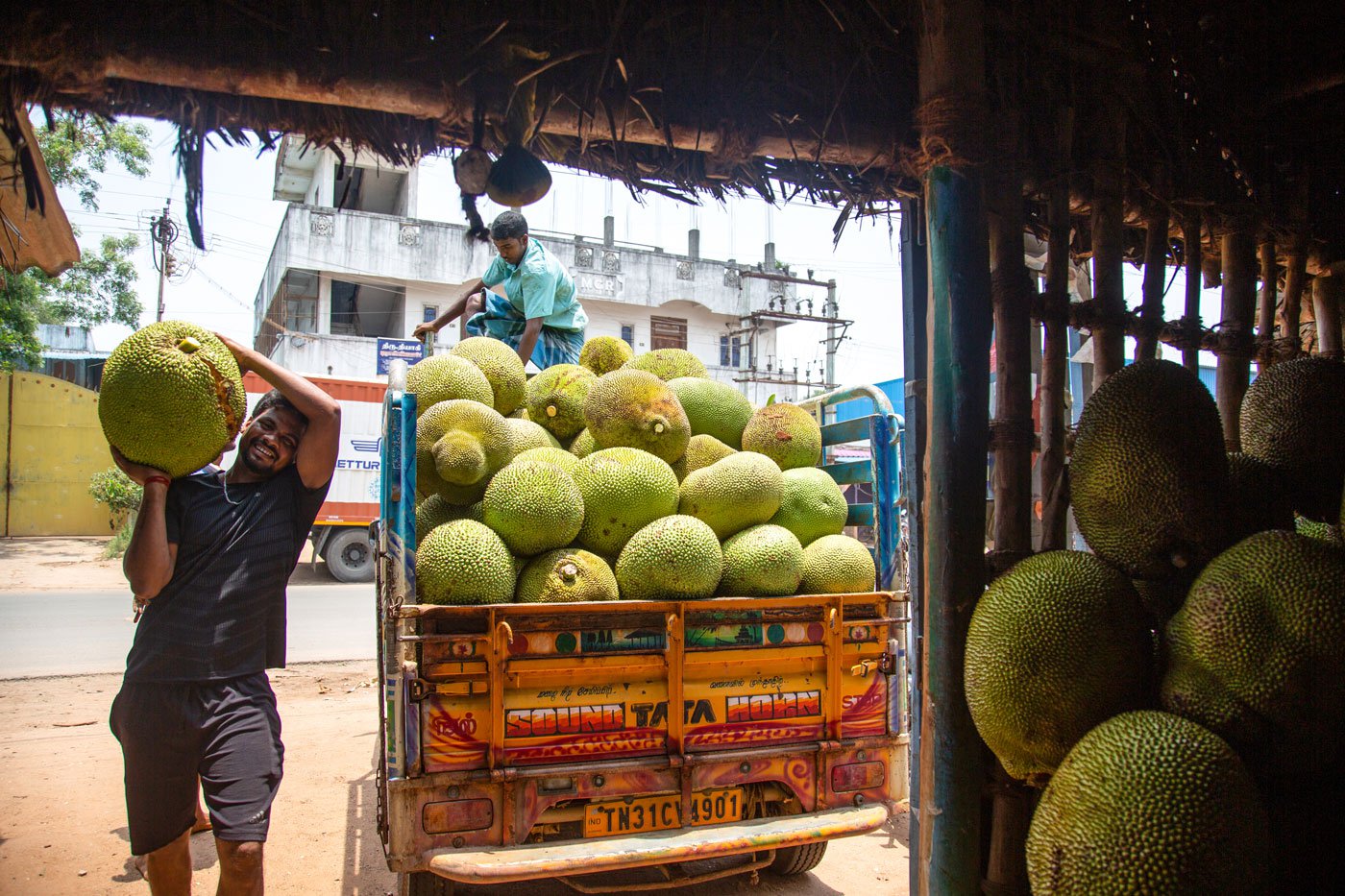
Jackfruit trading involves uncertainties. Even if the harvest is big, some fruits will rot, crack open, fall down and even get eaten by animals
While Padre is keen to highlight positive stories on jackfruit – and he lists many during the conversation, including yummy jackfruit ice creams in India – he doesn’t gloss over the problems. “The road map to success is figuring out the cold storage. The first priority is making ripe jackfruit available in frozen form throughout the year. It is not rocket science, but we haven’t taken even baby steps in that direction.”
Then there’s a problem unique to this fruit – you simply cannot tell the quality from the outside. Unlike Panruti, where jack is carefully harvested – and where there is an assured market for the fruit – elsewhere, there is no ready market in all the jackfruit growing areas. No farmer-friendly supply chains too. And this, in turn, leads to plenty of wastage.
What have we done to tackle the wastage, Padre asks. “Isn’t this also food? Why do we give so much importance to just rice and wheat?”
For business to improve, jackfruit from Panruti has to go everywhere – to every state, every country, says Vijaykumar. “There should be more publicity,” he says. “Only then will we get a good price.”
At Anna Fruit Market, in Chennai’s sprawling Koyambedu wholesale market complex, jackfruit traders have a similar ask: cold storage and better yard facilities. C.R. Kumaravel, who represents the traders here, says that the price fluctuates widely, from 100 to 400 rupees a fruit.
“In Koyambedu, we auction the fruit. When there’s a lot of supply, naturally the price falls. And there’s a lot of wastage – something like 5 or even 10 per cent. If we could keep and sell the fruit, farmers would benefit from better rates.” Kumaravel estimates the trade to be worth at least 50,000 rupees, per day, for each of the 10 shops. “But this is only during the season – around five months a year.”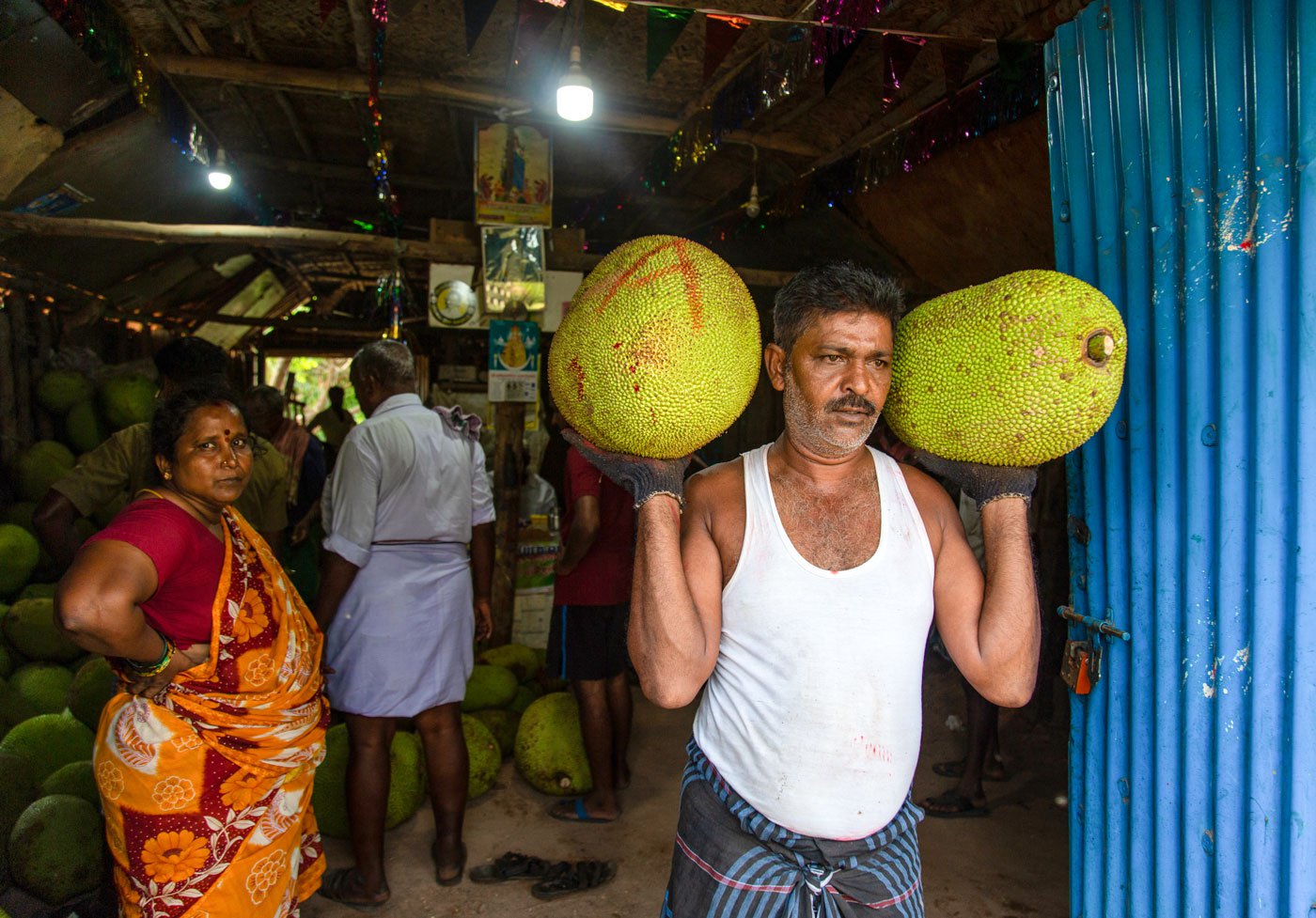
Jackfruits from Panruti are sent all over Tamil Nadu, and some go all the way to Mumbai
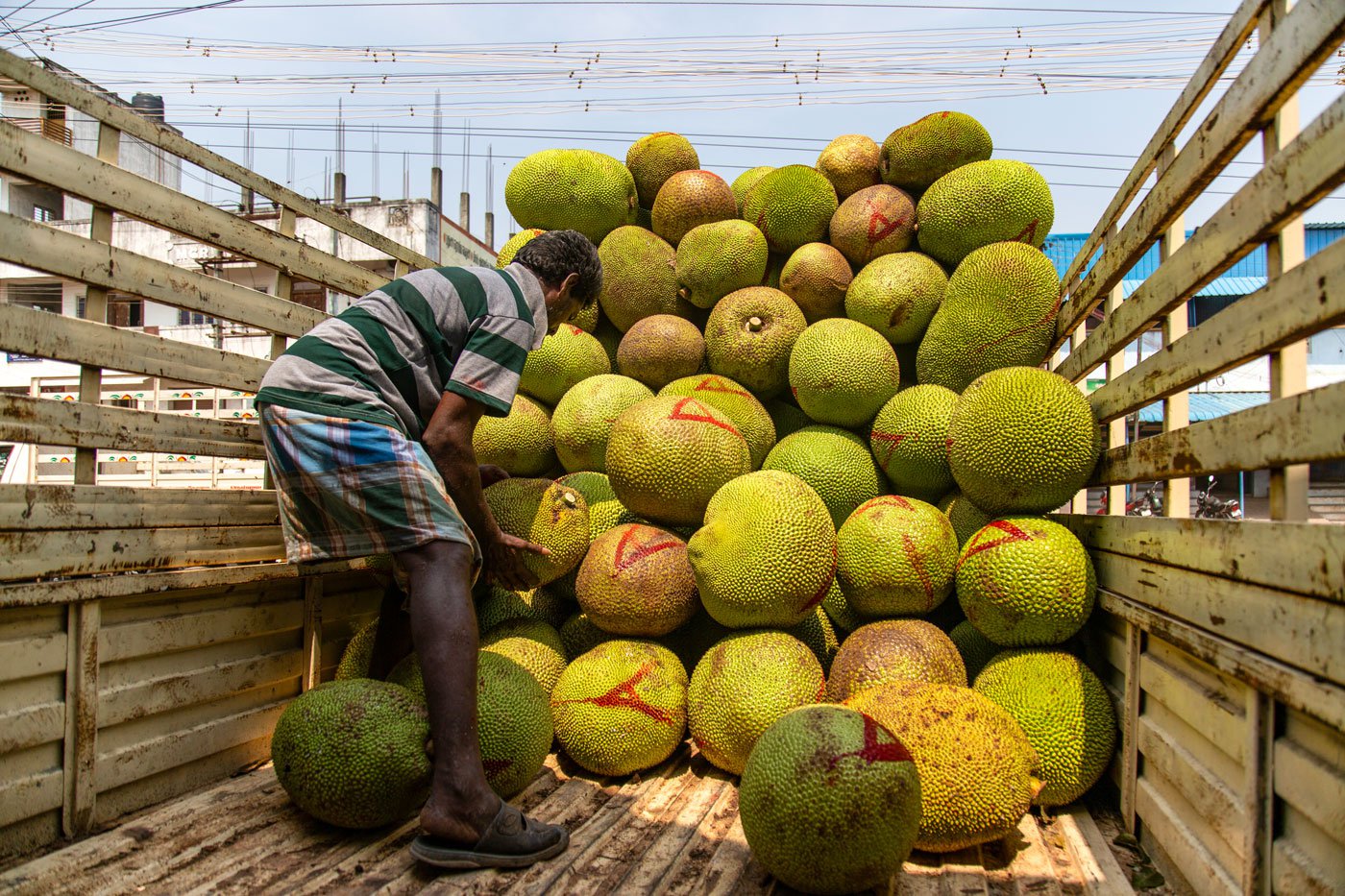
Absence of farmer-friendly supply chains and proper cold storage facilities lead to plenty of wastage
A 2022-23 policy note of Tamil Nadu Agriculture and Farmers Welfare Department holds some promise for jackfruit growers and, by extension, traders. The policy note mentions “a Special Centre for Jack is also being established in Panikankuppam village, Panruti block, Cuddalore district at an outlay of Rs. Five crore, to utilize the vast opportunities in jack cultivation and processing.”
The note adds that steps are on to get a geographical indication (GI) tag for Panruti jackfruit, to “fetch greater value in global markets.”
Lakshmi, though, is baffled that “many people don’t even know where Panruti is.” It was the 2002 Tamil film Solla Marandha Kadhai (A Forgotten Story) that made her town famous, she points out. “The director Thankar Bachan is from this area. I too appear in the film,” she says, with quiet pride. “It was very hot during the shoot, but it was interesting.”*****
Lakshmi is in great demand during the season. Jackfruit lovers have her phone number on speed dial. They know she will source them the best fruit.
And Lakshmi can actually do that. Not only is she connected with over 20 mandis in Panruti, she also knows many of the farmers who supply to them. Often, she even knows when their crop will be ready.
How does she track all of this? Lakshmi does not reply. It’s obvious – she’s been around for decades, it’s her job to know, and she does.
How did she get into such a male-dominated field? This time she gives me an answer. “People like you ask me to buy them fruit. And I get it for them at a good price.” She also looks out for the trader, she clarifies. It’s evident that traders and farmers respect her judgement. They welcome her and speak highly of her.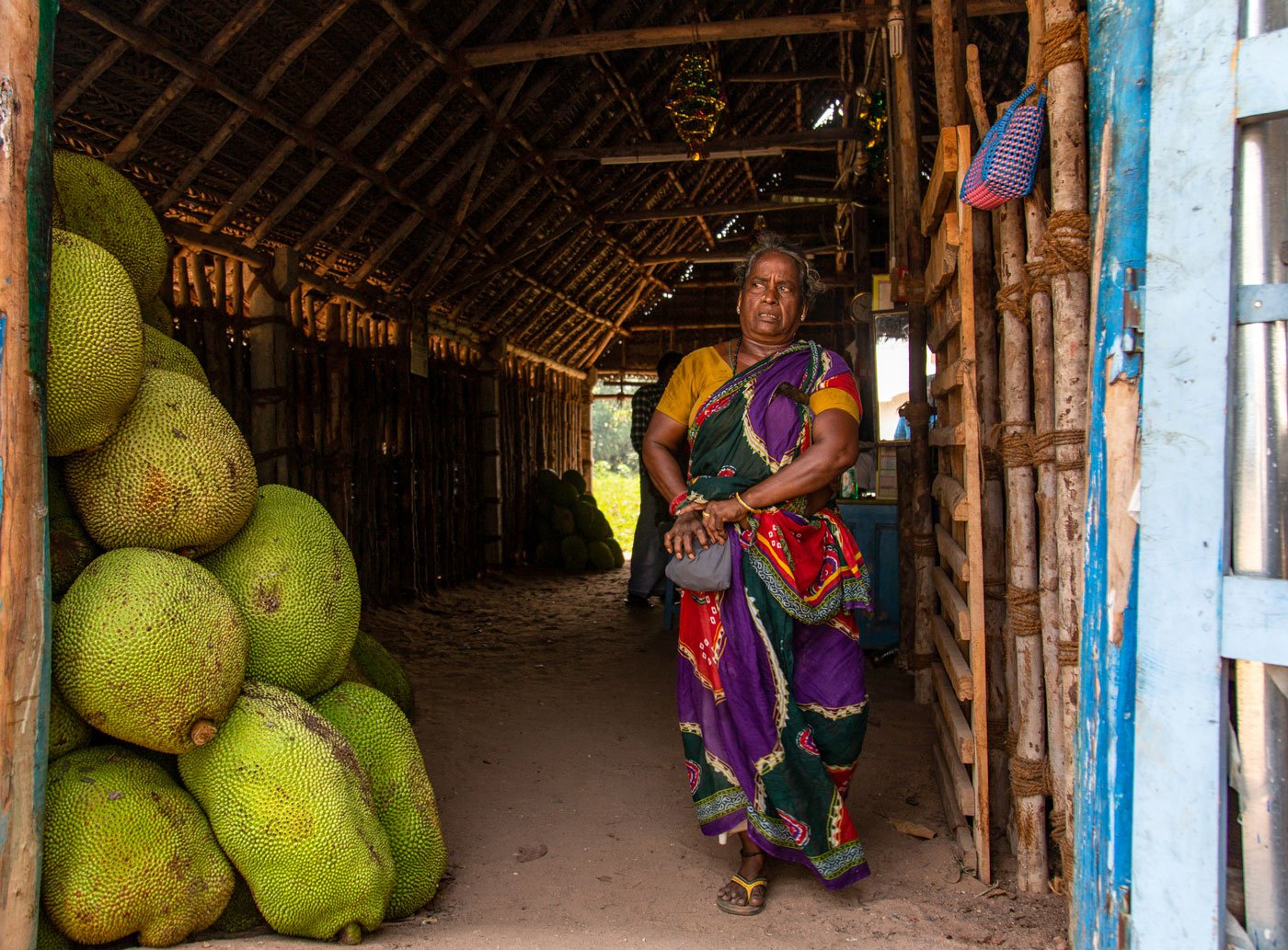
Lakshmi
sets the price for thousands of
kilos of jackfruit every year. She
is one of the very few senior
women traders in any agribusiness
In the area where she lives, everybody tells you where her house is. “But mine is only sillarai vyaparam (a small business),” she says, “I just get a good price for everybody.”
As each load of jackfruit comes to the mandi , Lakshmi checks the quality of the fruit before pricing it. All she needs for it is a knife. With a few taps, she can tell if it is ripe or raw, or ready to eat the next day. If at all she doubts her judgement, she double-checks by making a small incision and pulling out a pod. Although this is the gold standard test, it is rarely performed as it punctures the fruit.
“Last year, the same sized pala that went for 120 rupees now costs 250. The price is heavy because of this monsoon’s rain and damage to the crop.” In a couple of months (June), she predicts there will be 15 tonnes of fruit in each shop. And the rate will fall sharply.
The jackfruit trade has grown a lot since she came into the business, says Lakshmi. There are more trees, more fruits, and a lot more trade. Farmers, however, bring their produce to one particular commission agent. If loyalty is one reason, the loans that their particular agent extends them is another. Lakshmi explains that they borrow anywhere from 10,000 rupees to a lakh against the annual crop. And ‘adjust’ it against sales.
Her son Raghunath offers another explanation. “Farmers who have large tracts of pala maram have decided not to just sell the fruits – they want to add value and increase the profit.” They make chips and jams from jack, he says. Plus, the unripe fruit is cooked and used as a meat substitute.
“There are factories where the pods are dried and powdered,” Raghunath says. And that is boiled into a porridge and eaten. These products haven’t caught on yet – compared to the fruit – but the factory owners believe it will, over time.”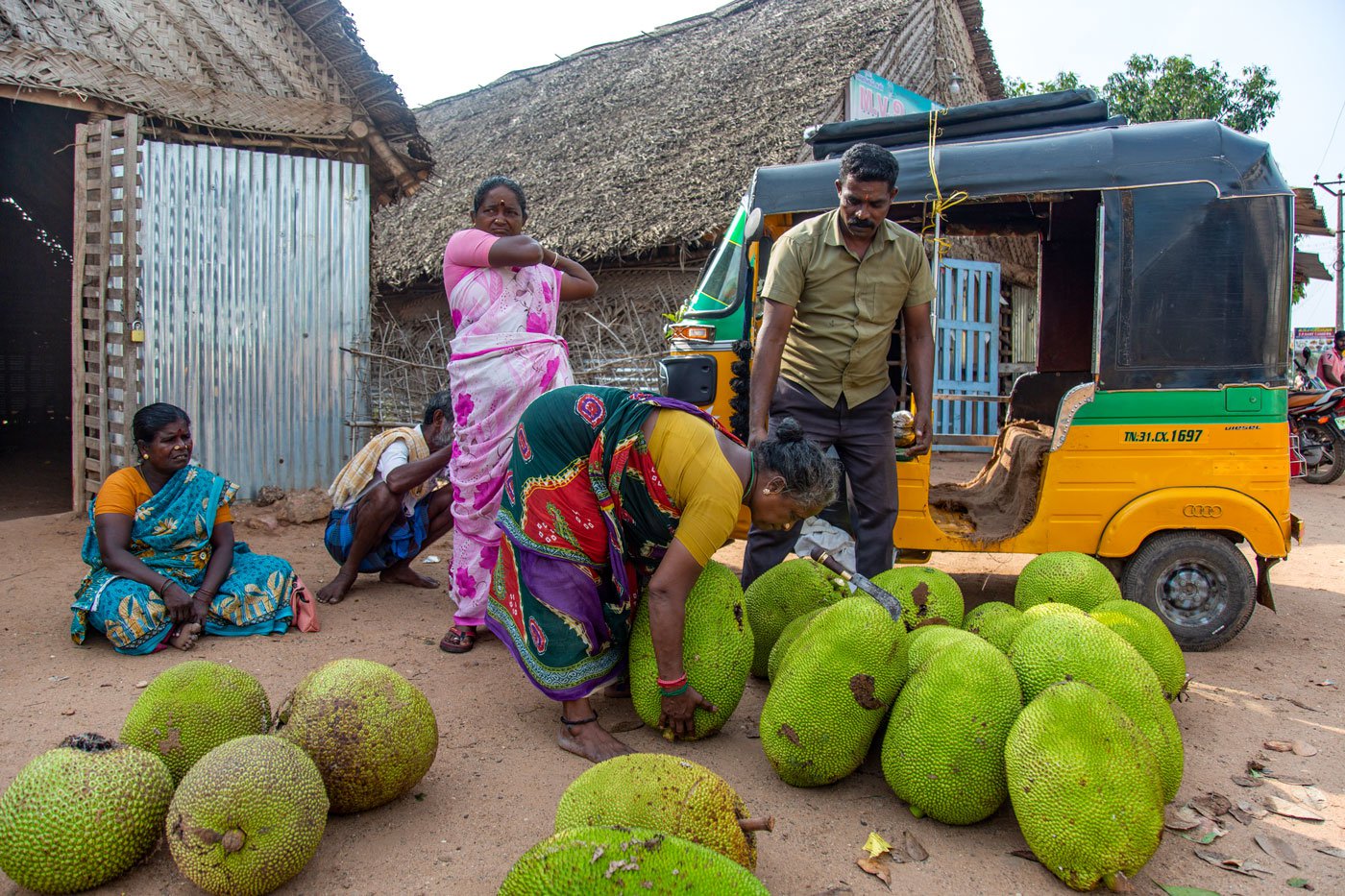
Lakshmi is in great demand during the season because people know she sources the best fruit
The house that Lakshmi built was entirely funded by jackfruits.
“This is 20 years old,” she says, touching the floor with her fingertips. But her husband died before the house came up. She had met him on her job, selling jackfruit on the train, travelling from Cuddalore to Panruti, where he had a tea stall.
Hers was a love marriage. The love still lingers in the beautiful portraits she commissioned an artist from Panruti to paint. The one of her husband cost her 7,000 rupees. And the other, of the two of them, was 6,000. She tells me many stories, her voice raspy but full of energy. I love the one about her dog: “So loyal, so clever, and dearly missed.”
It’s nearly 2 p.m., but Lakshmi has not yet eaten. I will, soon, she says, and keeps talking. During the season, she simply has no time for housework. Her daughter-in-law Kayalvizhi takes care of it.
Both of them tell me what they cook with jackfruit. “With the seeds, we make an
upma
. With the unripe pods, we remove the skin, boil it with turmeric powder, crush it in a mortar, then temper some
ulutham paruppu
[black gram], and finish it with some grated coconut. If the pod is floury, it can be tossed with some oil and eaten with chilli powder.” The seeds are added to
sambhar
, the unripe pods to
biriyani
. Lakshmi calls the dishes made with
pala
as “
arumai
” (fantastic) and “tasty”.
Mostly, Lakshmi is not too fussed about food. She drinks tea, or eats a meal in any nearby eatery. She has “pressure and sugar,” that is, high blood pressure and diabetes. “I have to eat on time, otherwise I feel dizzy.” She felt giddy that morning, and left Vijaykumar’s shop in a hurry. Even though her work entails long and late working hours, Lakshmi does not find it threatening. “There is no problem.”
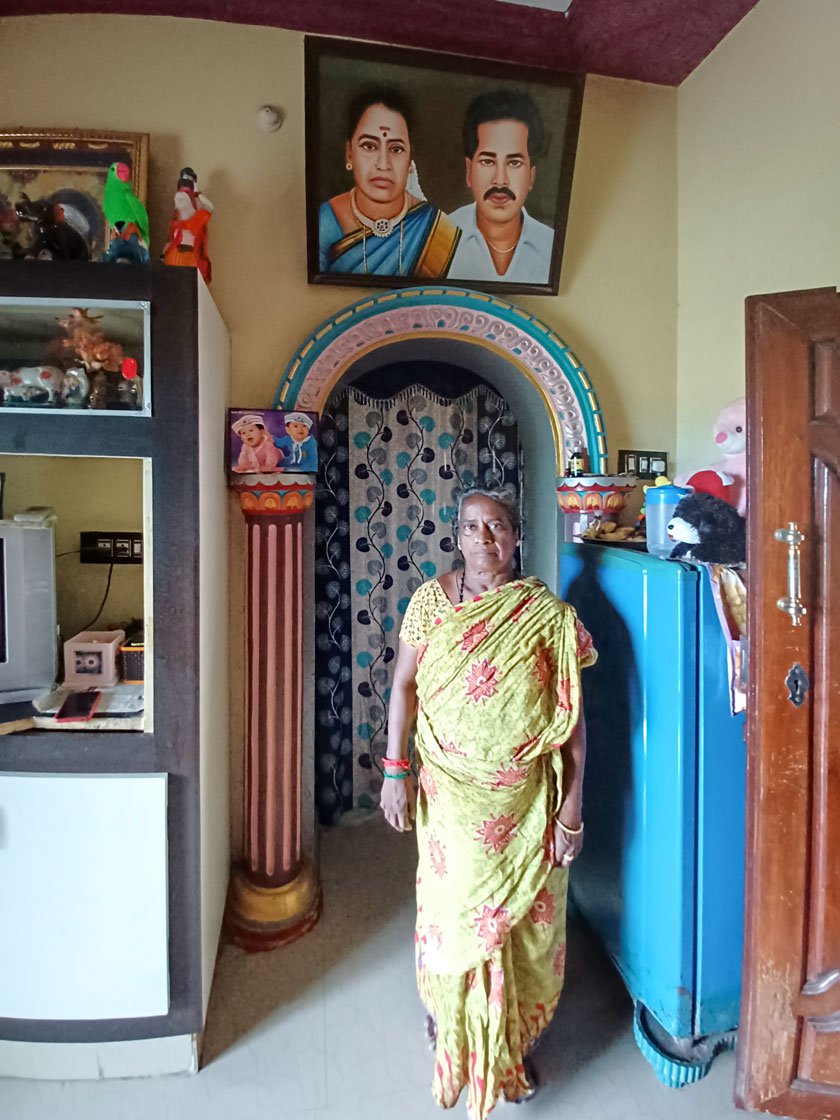
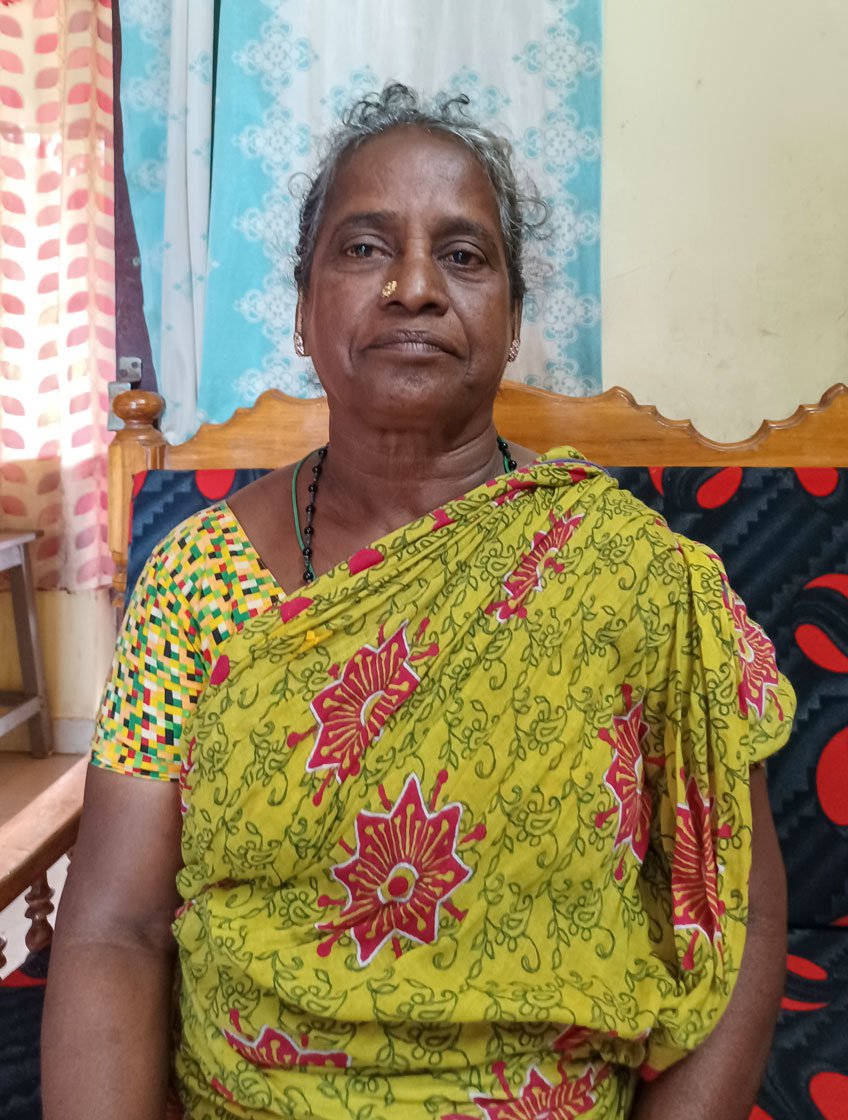
Left: Lakshmi standing in Lakshmi Vilas, the house she built by selling and trading jackfruits. On the wall is the painting of her and her husband that she had commissioned. Right: In a rare moment during the high season, Lakshmi sits on her sofa to rest after a long day at the mandi
Back in her train-vendor days, about 30 years ago, jackfruit was sold for 10 rupees. (It is anywhere between 20 and 30 times that price now.) Lakshmi recalls that the compartments were like pettis (boxes). There was no vestibule. As part of an unspoken agreement, only one seller got into a coach. Only after they got off, another would get in. “The ticket examiners then did not insist on fares and tickets. We travelled freely. But,” she tells me, lowering her voice, “we would give them some jackfruit…”
Those were passenger trains; they moved slowly and stopped in all the small stations. Many people who got in and out bought the fruit. Her earnings were small, though. She’s unclear of the exact amount she made in a day, but says “100 rupees was a very big sum back then.”
“I didn’t go to school. My parents died when I was very young.” To make a living, she travelled on many train lines: Chidambaram, Cuddalore, Chengelput, Villupuram, selling fruit. “For my meals, I used to buy tamarind or curd rice from the canteens in the stations. When I needed to, I used the latrine in the compartment, after parking my jackfruit tray on the luggage shelf. It was such hard work. But what choice did I have?”
Now she has a choice – she stays at home and rests when the jackfruit season is over. “I go to Chennai and spend two weeks here or there, with my relatives. The rest of the time, I’m here with my grandson Sarvesh,” she says, smiling at the little boy playing nearby.
Kayalvizhi fills in some more details. “She helps all her relatives; she gets them jewellery. If someone asks for help, she never says no…”
Lakshmi must have heard the word ‘no’ many times early in her career. Here is someone who transformed her life with her “sondha uzhaippu” (own labour). Listening to her story is a bit like eating jackfruit – you don’t expect to find such a sweetness. And when you do, it is so memorable.
This research study is funded by Azim Premji University as part of its Research Funding Programme 2020.
